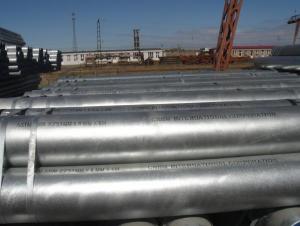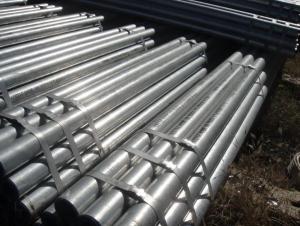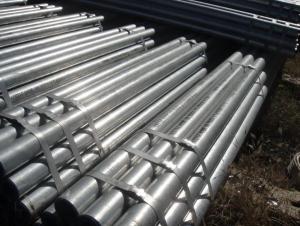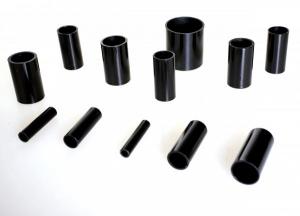ASTM A53 Heavy Hot Dipped Galvanized Pipe
- Loading Port:
- Tianjin
- Payment Terms:
- TT or LC
- Min Order Qty:
- 50 m.t.
- Supply Capability:
- 5000 m.t./month
OKorder Service Pledge
OKorder Financial Service
You Might Also Like
Application: It is widely used in building, machine, chemical equipment, automobile industrial, container, it is also applied to agriculture and mine machine.
Standard:ASTM A53,BS1387,GB3091
Steel grade: ASTM A53: A, B, C GB3091, BS1387:Q195,Q215,Q235
Thickness of zinc coating: 100g/m2, 120g/m2, 150g/m2, 200g/m2, 250g/m2, 300g/m2, 350g/m2. 400g/m2
Packaging & Delivery: Container or Bulk Cargo Negotiable
Size of Pipe:
OD(MM)
WT(MM) |
21.3 |
26.7 |
33.4 |
42.2 |
48.3 |
60.3 |
73 |
88.9 |
114.3 |
141.3 |
168.3 |
219.1 |
1.70 | √ | √ | √ | √ |
|
|
|
|
|
|
|
|
1.80 | √ | √ | √ | √ |
|
|
|
|
|
|
|
|
1.90 | √ | √ | √ | √ | √ | √ |
|
|
|
|
|
|
2.00 | √ | √ | √ | √ | √ | √ |
|
|
|
|
|
|
2.10 | √ | √ | √ | √ | √ | √ |
|
|
|
|
|
|
2.20 | √ | √ | √ | √ | √ | √ |
|
|
|
|
|
|
2.30 | √ | √ | √ | √ | √ | √ |
|
|
|
|
|
|
2.40 | √ | √ | √ | √ | √ | √ |
|
|
|
|
|
|
2.50 | √ | √ | √ | √ | √ | √ | √ | √ | √ |
| √ |
|
2.75 |
|
| √ | √ | √ | √ | √ | √ | √ | √ | √ | √ |
3.00 |
|
| √ | √ | √ | √ | √ | √ | √ | √ | √ | √ |
3.25 |
|
| √ | √ | √ | √ | √ | √ | √ | √ | √ | √ |
3.50 |
|
|
|
|
| √ | √ | √ | √ | √ | √ | √ |
3.75 |
|
|
|
|
|
| √ | √ | √ | √ | √ | √ |
4.00 |
|
|
|
|
|
|
| √ | √ | √ | √ | √ |
4.25 |
|
|
|
|
|
|
|
|
| √ | √ | √ |
4.50 |
|
|
|
|
|
|
|
|
|
| √ | √ |
4.75 |
|
|
|
|
|
|
|
|
|
|
| √ |
5.00 |
|
|
|
|
|
|
|
|
|
|
| √ |
5.25 |
|
|
|
|
|
|
|
|
|
|
| √ |
ASTM A53
ASTM A53 LIGHT ( HOT DIPPED GALVANIZED PIPES) | ||||||||||||||||
SIZE | Max | Min | Wall Thickness | Bare Pipes Weight | Screwed & Socketed Pipes Weight | |||||||||||
INCH | NB(MM) | mm | mm | mm | kg/m | kg/m | ||||||||||
1/2" |
15 |
21.4 |
21 |
2 |
0.947 |
0.956 | ||||||||||
3/4" |
20 |
26.9 |
26.4 |
2.3 |
1.38 |
1.39 | ||||||||||
1" |
25 |
33.8 |
33.2 |
2.6 |
1.98 |
2 | ||||||||||
1-1/4" |
32 |
42.5 |
41.9 |
2.6 |
2.54 |
2.57 | ||||||||||
1-1/2" |
40 |
48.4 |
47.8 |
2.9 |
3.23 |
3.27 | ||||||||||
2" |
50 |
60.2 |
59.6 |
2.9 |
4.08 |
4.15 | ||||||||||
2-1/2" |
65 |
76 |
75.2 |
3.2 |
5.71 |
5.83 | ||||||||||
3" |
80 |
88.7 |
87.9 |
3.2 |
6.72 |
6.39 | ||||||||||
3-1/2" | 90 | 113.9 | 113 | 3.6 | 9.75 | 10 | ||||||||||
ASTM A53 MEDIUME ( HOT DIPPED GALVANIZED PIPES) | ||||||||||||||||
SIZE | Max | Min | Wall Thickness | Bare Pipes Weight | Screwed & Socketed Pipes Weight | |||||||||||
INCH | NB(MM) | mm | mm | mm | kg/m | kg/m | ||||||||||
1/2" |
15 |
21.7 |
21.1 |
2.6 |
1.21 |
1.22 | ||||||||||
3/4" |
20 |
27.2 |
26.6 |
2.6 |
1.54 |
1.57 | ||||||||||
1" |
25 |
34.2 |
33.4 |
3.2 |
2.41 |
2.43 | ||||||||||
1-1/4" |
32 |
42.9 |
42.1 |
3.2 |
3.1 |
3.13 | ||||||||||
1-1/2" |
40 |
48.9 |
48.3 |
3.2 |
3.57 |
3.61 | ||||||||||
2" |
50 |
60.8 |
59.9 |
3.6 |
5.03 |
5.1 | ||||||||||
2-1/2" |
65 |
76.6 |
75.4 |
3.6 |
5.43 |
6.55 | ||||||||||
3" |
80 |
89.5 |
88.1 |
4.5 |
8.37 |
8.54 | ||||||||||
4" |
100 |
114.9 |
113.3 |
4.5 |
12.2 |
12.5 | ||||||||||
5" |
125 |
140.6 |
138.7 |
5 |
15.6 |
17.1 | ||||||||||
6" |
150 |
166.1 |
164.1 |
5 |
19.7 |
20.3 | ||||||||||
ASTM A53 HEAVY ( HOT DIPPED GALVANIZED PIPES) | ||||||||||||||||
SIZE | Max | Min | Wall Thickness | Bare Pipes Weight | Screwed & Socketed Pipes Weight | |||||||||||
INCH | NB(MM) | mm | mm | mm | kg/m | kg/m | ||||||||||
1/2" |
15 |
21.7 |
21.1 |
3.2 |
1.44 |
1.45 | ||||||||||
3/4" |
20 |
27.2 |
26.6 |
3.2 |
1.87 |
1.88 | ||||||||||
1" |
25 |
34.2 |
33.4 |
4 |
2.94 |
2.96 | ||||||||||
1-1/4" |
32 |
42.9 |
42.1 |
4 |
3.8 |
3.83 | ||||||||||
1-1/2" |
40 |
48.9 |
48.3 |
4 |
4.38 |
4.42 | ||||||||||
2" |
50 |
60.8 |
59.9 |
4.5 |
5.19 |
5.26 | ||||||||||
2-1/2" |
65 |
76.6 |
75.4 |
4.5 |
7.93 |
8.05 | ||||||||||
3" |
80 |
89.5 |
88.1 |
5 |
10.3 |
10.5 | ||||||||||
4" |
100 |
114.9 |
113.3 |
5.4 |
14.5 |
14.9 | ||||||||||
5" |
125 |
140.6 |
138.7 |
5.4 |
17.9 |
18.4 | ||||||||||
6" |
150 |
166.1 |
164.1 |
5.4 |
21.3 |
22.9 | ||||||||||
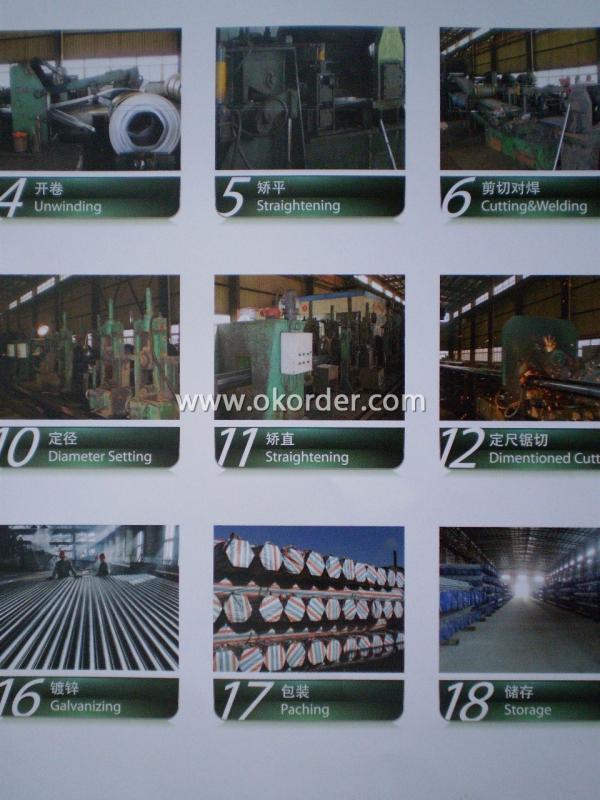
- Q:The plastic pipe and steel pipe difference
- In the plastic coated galvanized steel pipe inside the plastic coated manufacturing method. The thickness of the internal plastic is thin, which is equal to a plastic skin.
- Q:What are the applications of galvanized steel pipes?
- Galvanized steel pipes have a wide range of applications across various industries. They are commonly used in plumbing systems for water supply and drainage systems due to their corrosion resistance and durability. Additionally, they are used in the construction industry for structural supports, scaffolding, and fencing. Galvanized steel pipes are also widely utilized in agricultural irrigation systems and in the transportation of liquids and gases.
- Q:Where is a steel pipe casing usually used?
- A straight tube of carbon steel sheathed on pipes and tubes and threading tubes to protect the joints from damage by electric welding. The purpose is to protect the wires and cables.
- Q:What are the safety measures to be followed while working with steel pipes?
- There are several safety measures that should be followed while working with steel pipes. Firstly, it is important to wear appropriate personal protective equipment (PPE) such as safety glasses, gloves, and steel-toed boots to protect against potential hazards. Secondly, workers should be cautious of sharp edges or burrs on the pipes and handle them with care to avoid cuts or injuries. Additionally, proper lifting techniques should be employed when moving heavy steel pipes to prevent strains or back injuries. It is also crucial to secure pipes properly during transport or storage to prevent accidents. Finally, workers should be trained on the safe use of tools and equipment associated with steel pipe work to minimize the risk of accidents or damage.
- Q:What are the advantages of using steel pipes in the manufacturing of appliances?
- There are several advantages of using steel pipes in the manufacturing of appliances. Firstly, steel pipes offer high strength and durability, ensuring a long lifespan for the appliances. Secondly, steel pipes have excellent corrosion resistance properties, which is crucial in appliances that come into contact with water or other corrosive substances. Thirdly, steel pipes can withstand high temperatures, making them suitable for appliances that generate heat. Additionally, steel pipes provide a smooth and efficient flow of fluids or gases, enhancing the overall performance of the appliances. Lastly, steel pipes are readily available and cost-effective, making them a preferred choice for manufacturers.
- Q:What are the common factors affecting the lifespan of steel pipes?
- The common factors affecting the lifespan of steel pipes include corrosion, external damage or impact, poor installation or maintenance practices, and exposure to extreme temperatures or harsh environments.
- Q:How are steel pipes classified based on their end connections?
- Steel pipes can be classified based on their end connections into threaded, socket weld, butt weld, and flanged connections.
- Q:What does "DN25 PN16" mean?
- The welded steel pipe can be divided into thin-wall steel tube, ordinary steel pipe and thickened steel tube according to the thickness. Its nominal diameter is neither external diameter nor internal diameter, but a nominal size similar to the diameter of the ordinary steel pipe. Each nominal diameter corresponds to an outer diameter, and the inner diameter varies with the thickness. Nominal diameter can be expressed in metric mm, also available in English in. With nominal diameter pipeline accessories, meaning with tube. "DN25" means the inner diameter of the steel pipe is 25MM.
- Q:What are the different grades of steel used for pipes?
- Pipes are manufactured using various grades of steel, each possessing unique properties and applications. Some commonly utilized grades include: 1. Carbon Steel: This type of steel is widely employed in pipe manufacturing, particularly for low-pressure purposes. It contains a low carbon content, typically less than 0.30%, facilitating easy welding and forming. Carbon steel pipes are known for their durability and cost-effectiveness, making them suitable for diverse industries. 2. Stainless Steel: Stainless steel pipes are renowned for their corrosion resistance and high strength. They consist of an alloy of iron and chromium, with additional elements like nickel and molybdenum enhancing their properties. These pipes find extensive usage in industries such as chemical processing, food production, and oil and gas, where corrosion resistance is vital. 3. Alloy Steel: Alloy steel pipes are created by incorporating elements like manganese, chromium, or nickel into carbon steel. This enhances their strength, hardness, and wear resistance, rendering them appropriate for high-pressure and high-temperature applications. Industries such as power generation, petrochemical, and aerospace frequently employ alloy steel pipes. 4. Duplex Steel: Duplex steel represents a type of stainless steel that combines austenite and ferrite phases. This results in a material possessing exceptional strength, corrosion resistance, and toughness. Duplex steel pipes are commonly utilized in offshore oil and gas platforms, as well as in chemical and petrochemical industries. 5. Low-Temperature Steel: Low-temperature steel is specifically designed to withstand extremely cold temperatures without becoming brittle. These pipes find significant use in industries such as cryogenic storage, LNG transportation, and refrigeration. Choosing the appropriate grade of steel is crucial to ensure optimal pipe performance and longevity. Factors such as temperature, pressure, corrosion resistance, and cost should be taken into account when selecting the steel grade for pipes.
- Q:What are the environmental impacts of using steel pipes?
- The environmental impacts of using steel pipes include the extraction and processing of raw materials, energy consumption during manufacturing, and carbon emissions. Additionally, the disposal of steel pipes can contribute to landfill waste. However, steel pipes are highly durable, recyclable, and have a long lifespan, which mitigates some of these negative impacts.
1. Manufacturer Overview |
|
|---|---|
| Location | Tianjin, China |
| Year Established | 1999 |
| Annual Output Value | Above Thirty Million RMB |
| Main Markets | Main land; Middle East; Southeast Asia |
| Company Certifications | ISO 9001:2011;CE:2010 |
2. Manufacturer Certificates |
|
|---|---|
| a) Certification Name | |
| Range | |
| Reference | |
| Validity Period | |
3. Manufacturer Capability |
|
|---|---|
| a)Trade Capacity | |
| Nearest Port | Tianjin |
| Export Percentage | 30% - 40% |
| No.of Employees in Trade Department | 101-200 People |
| Language Spoken: | English; Chinese |
| b)Factory Information | |
| Factory Size: | 50,000 square meters |
| No. of Production Lines | Above 14 |
| Contract Manufacturing | Hui Ke Steel Pipe Co,.Ltd |
| Product Price Range | Average |
Send your message to us
ASTM A53 Heavy Hot Dipped Galvanized Pipe
- Loading Port:
- Tianjin
- Payment Terms:
- TT or LC
- Min Order Qty:
- 50 m.t.
- Supply Capability:
- 5000 m.t./month
OKorder Service Pledge
OKorder Financial Service
Similar products
New products
Hot products
Hot Searches
Related keywords
